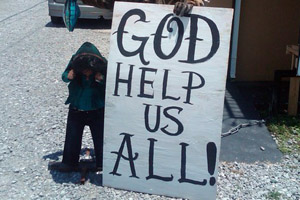This post, first published on Grist, appears here courtesy of the Climate Desk collaboration.
With the Gulf oil spill continuing unabated, powering a 21st century economy on a 19th century fossil fuel looks less and less smart by the day.
Luckily, we’ve got other options. I described the most promising steps the federal government could take toward reducing oil use in transportation systems last week. But local governments don’t have to wait for federal action. Through smart land use, cities, towns, and many rural areas can give residents the option of driving less—a direct way to stem the demand for offshore (and foreign) oil.
I spoke with leaders of the Smart Growth movement, along with advocates for economic justice, to learn about solutions that don’t require new technology and, in many cases, pay for themselves. Want to do something in your own community to respond to BP’s oil spill? Here are ten changes worth considering:
1. Complete streets. Towns and cities can’t rebuild their roadways overnight to make them safe for walkers, bikers, children, and wheelchair users. But they can pass Complete Streets policies that require all renovations and new roads to be designed for a full range of users, not just autos. Places as diverse as Charlotte, N.C., Salt Lake City, and Hernando, Miss. (pop. 6,812), have adopted such plans, which encourage traffic-calming elements like curb extensions, bike lanes, median islands, and pedestrian signals.
 Arlington County, Va.’s, most intense development follows its Metrorail line. Wikimedia Commons2. Build near transit. Subway and light rail lines don’t come cheap, so cities that have them should make the most of them by surrounding stations with useful services—residential, retail, office, and medical space—rather than parking lots. Development along the Metrorail in Arlington County, Va., (right) is a textbook example. One caveat: New transit stops drive up property values, so it’s key to pair transit-oriented development with affordable housing measures to keep from pricing out low-income residents, according to Judith Bell, president of the Oakland equitable development nonprofit Policylink.
Arlington County, Va.’s, most intense development follows its Metrorail line. Wikimedia Commons2. Build near transit. Subway and light rail lines don’t come cheap, so cities that have them should make the most of them by surrounding stations with useful services—residential, retail, office, and medical space—rather than parking lots. Development along the Metrorail in Arlington County, Va., (right) is a textbook example. One caveat: New transit stops drive up property values, so it’s key to pair transit-oriented development with affordable housing measures to keep from pricing out low-income residents, according to Judith Bell, president of the Oakland equitable development nonprofit Policylink.
3. Let the market lead. Consumer demand for compact, transit-friendly development has been rising—a recent study of construction trends found that urban neighborhoods have more than doubled their share of home construction in most metro areas. But many zoning codes make new compact neighborhoods illegal by requiring minimum lot sizes, street widths, street setbacks, and parking space. Removing these restrictions—something small-government libertarians should support—would address the problem of mandated sprawl.
4. Demand density. Form-based zoning lets local governments decide the characteristics an area should have (say, mixed use and medium density), then require developers to meet those standards. Taxpayers have good reason to demand such proactive planning, since sprawling development requires more public spending on roads and water and sewage lines. The recession is a natural time to revisit zoning codes, said David Goldberg, author and communications director for Smart Growth America. “Obviously, in terms of building, we’re not doing a whole lot right now,” he said. “But the downturn is a good time to take a look at zoning codes and see where they are promoting the stuff that’s bad for us in the long term.”
5. Cut parking. Few planning issues inflame emotions like parking, and few affect the quality of a place as much—parking eats up space, reduces walkability, and adds an incentive to drive. Slashing parking won’t fly everywhere, but towns can plan for parking areas to be redeveloped in the future, when other transportation options arrive. Many codes have arbitrary requirements—four spaces per thousand feet of office space, or two spaces per bedroom—that don’t account for transit access and others surroundings. “There’s no science to what most zoning codes require for parking,” said Goldberg. “People go to war as though it were holy writ. But the truth is that these ratios were pulled out of the air a long time ago.”
6. Free parking for car sharers. Car-sharing programs such as Zip Car and the Center for Neighborhood Technology’s I-GO take some 17 cars off roads for each one they add, according to CNT president Scott Bernstein. Cities, which control massive amounts of parking space, could encourage such programs by giving members free or steeply reduced parking. They could also designate those vehicles as transit, rather than rental cars, to reduce their cost. Many such programs run off sensor cards, which could be integrated with transit cards to encourage usage.
 Bike corral in Portland—where else? Bikeportland.org 7. Bike corrals. In the low-budget category, street-side bike parking “corrals” fit more vehicles than parking spaces and leave sidewalks free for other uses. In Portland, Ore., 84 percent of merchants in a recent survey thought new bike corrals improved a streetscape.
Bike corral in Portland—where else? Bikeportland.org 7. Bike corrals. In the low-budget category, street-side bike parking “corrals” fit more vehicles than parking spaces and leave sidewalks free for other uses. In Portland, Ore., 84 percent of merchants in a recent survey thought new bike corrals improved a streetscape.
8. Be like Times Square. Last year New York City experimented with closing Times Square and stretches of Broadway to autos. The change proved so popular with retailers and tourists that the city made it permanent. Towns could do the same with downtown squares to privilege walking and biking and to signify that main streets are places in themselves, not just routes to somewhere else.
 Rathausmarkt Bus Station, Hamburg, Germany Matt Yglesias9. Electronic bus schedules. Posting real-time schedules at bus and rail stations removes guesswork and uncertainty from using transit, making it more appealing to occasional users. If your bus is 10 minutes late, you’ll know it. Yes, there are apps that do this, but GPS-powered signs make it a public service.
Rathausmarkt Bus Station, Hamburg, Germany Matt Yglesias9. Electronic bus schedules. Posting real-time schedules at bus and rail stations removes guesswork and uncertainty from using transit, making it more appealing to occasional users. If your bus is 10 minutes late, you’ll know it. Yes, there are apps that do this, but GPS-powered signs make it a public service.
10. Fight the powers that be. Even places that want to kick auto dependency face pressure from the petroleum industry, surrounding towns, and state transportation planners to add expensive highway and bridge projects. Leaders in the city of Seattle have fought tooth and nail to keep state politicians from building a $6 billion auto-only tunnel through the city’s downtown. If cities want to add transit and bus service, they’ll have to ward off short-sighted road expansions.
Congress still controls some of the most important decisions for cutting the demand for oil. The Senate’s climate bill—the American Power Act—would include $7 billion a year to fund Smart Growth initiatives, according to one analysis. And emergency operating aid to transit systems could have the largest short-term impact on oil demand—84 percent of networks have cut services, raised fares, or are considering such measures, according to the American Public Transportation Association. Those cuts fall hardest on low-income residents with few alternatives.
But Congress is…well, Congress. The rest of us don’t need to wait.















